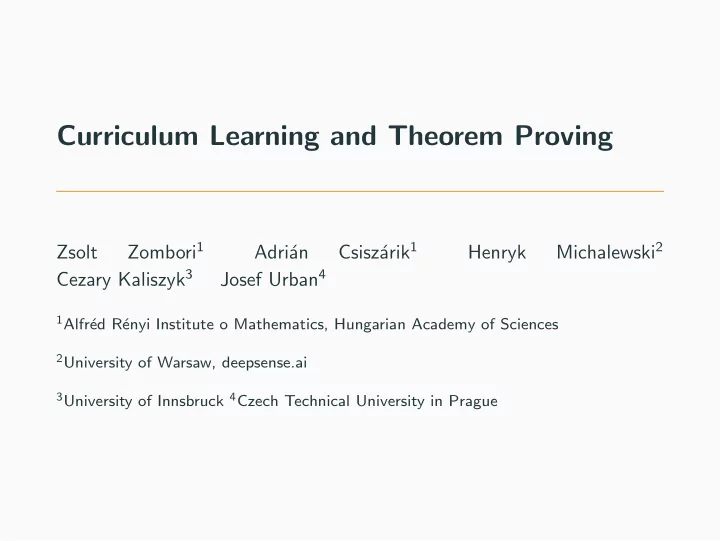

Curriculum Learning and Theorem Proving Zombori 1 arik 1 Michalewski 2 Zsolt Adri´ an Csisz´ Henryk Cezary Kaliszyk 3 Josef Urban 4 1 Alfr´ ed R´ enyi Institute o Mathematics, Hungarian Academy of Sciences 2 University of Warsaw, deepsense.ai 3 University of Innsbruck 4 Czech Technical University in Prague
Motivation 1. ATPs tend to only find short proofs - even after learning 2. AITP systems typically trained/evaluated on large proof sets - hard to see what the system has learned • Can we build a system that learns to find longer proofs? • What can be learned from just a few (maybe one) proof? 1
Aim • Build an internal guidance system for theorem proving • Use reinforcement learning • Train on a single problem • Try to generalize to long proofs with very similar structure 2
Domain: Robinson Arithmetic %theorem: mul(1,1) = 1 fof(zeroSucc, axiom, ! [X]: (o != s(X))). fof(diffSucc, axiom, ! [X,Y]: (s(X) != s(Y) | X = Y)). fof(addZero, axiom, ! [X]: (plus(X,o) = X)). fof(addSucc, axiom, ! [X,Y]: (plus(X,s(Y)) = s(plus(X,Y)))). fof(mulZero, axiom, ! [X]: (mul(X,o) = o)). fof(mulSucc, axiom, ! [X,Y]: (mul(X,s(Y)) = plus(mul(X,Y),X))). fof(myformula, conjecture, mul(s(o),s(o)) = s(o)). • Proofs are non trivial, but have a strong structure • See how little supervision is required to learn some proof types 3
Challenge for Reinforcement learning • Theorem proving provides sparse, binary rewards • Long proofs provide extremely little reward 4
Idea • Use curriculum learning • Start learning from the end of the proof • Gradually move starting step towards the beginning of proof 5
Reinforcement Learning Approach • Proximal Policy Optimization (PPO) • Actor - Critic Framework • Actor learns a policy (what steps to take) • Critic learns a value (how promising is a proof state) • Actor is confined to change slowly to increase stability 6
PPO challenges • Action space is not fixed (different at each step) • Action space cannot be directly parameterized • Guidance cannot ”output” the correct action • Guidance takes the state - action pair as input and returns a score 7
Technical Details • ATP: LeanCoP (ocaml / prolog) • Connection tableau based • Available actions are determined by the axiom set (does not grow) • Returns (hand designed) Enigma features • Machine learning in python • Learner is a 3-4 layer deep neural network • PPO1 implementation of Stable Baselines 8
Evaluation: STAGE 1 • N 1 + N 2 = N 3 , N 1 × N 2 = N 3 • Enough to find a good ordering of the actions • Can be fully mastered from the proof of 1 × 1 = 1 • Useful: • Some reward for following the proof 9
Evaluation: STAGE 2 • RandomExpr = N • Features from the current goal become important • Couple ”rare” actions • Can be mastered from the proof of 1 × 1 × 1 = 1 • Useful: • Features from the current goal • Oversample positive trajectories 10
Evaluation: STAGE 3 • RandomExpr 1 = RandomExpr 2 • More features required • ”Rare” events tied to global proof progress • Trained on 4-5 proofs, we can learn 90% of problems • Useful: • Features from the path • Features from other open goals • Features from the previous action • Random perturbation of the curriculum stage • Train on several proofs in parallel 11
Future work • Extend Robinson arithmetic with other operators • Learn on multiple proofs to master multiple strategies in parallel • Try some other RL approaches • Move beyond Robinson 12
Recommend
More recommend